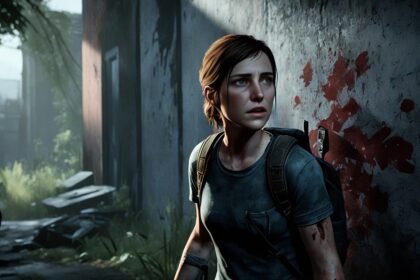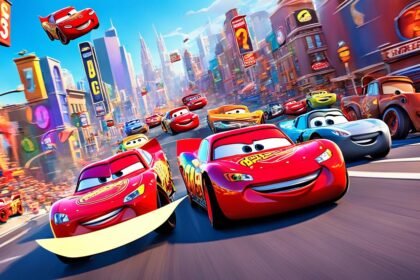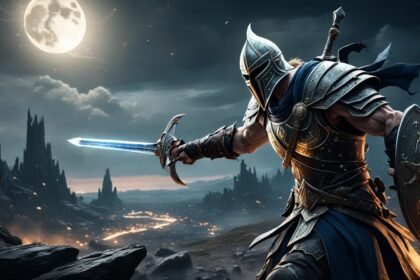After a tough start, Apocalypse Now became a standout in movie history. It was directed by Francis Ford Coppola. The story was based on Joseph Conrad’s Heart of Darkness. It takes us into the scary world of the Vietnam War. The movie is still powerful today.
Apocalypse Now takes place during the Vietnam War. It tells the story of Captain Benjamin Willard. He’s played by the amazing Martin Sheen. Willard’s mission is dangerous. He’s traveling down the Nung River to kill a powerful and rogue officer, Colonel Kurtz. Marlon Brando plays Kurtz.
The movie is about the effects of war and difficult choices. As Willard gets closer to his target, he finds out very dark truths about people. He has to deal with very tough situations. This makes him question his own sanity.
The movie has great acting, with Robert Duvall as Colonel Kilgore. Duvall worked with Coppola before in The Godfather. Their teamwork in this film is remarkable.
The film looks amazing, thanks to Vittorio Storaro’s work. His camera work is a big reason the movie is so intense and real. It throws viewers right into the heart of the war.
Apocalypse Now is more than just a war movie. It makes us think about the point of war and the power of the human mind. The film’s dark exploration of war’s effects and confusing morals still make viewers talk.
Key Takeaways:
- The film Apocalypse Now is a loose reinterpretation of Joseph Conrad’s novella Heart of Darkness.
- Apocalypse Now explores the psychological effects of the Vietnam War through the journey of Captain Benjamin Willard.
- Memorable performances by Martin Sheen, Marlon Brando, and Robert Duvall contribute to the film’s enduring appeal.
- The cinematic brilliance of Apocalypse Now includes exceptional cinematography by Vittorio Storaro.
- The film’s exploration of the darkness within humanity and the moral complexities of war make it a thought-provoking masterpiece.
The Troubled Production of Apocalypse Now
The making of Apocalypse Now was filled with tales of struggle. The team faced many challenges, from running out of money to facing real-life peril on the set. Yet, against all odds, they succeeded in creating a masterpiece.
Director Francis Ford Coppola faced a huge task. He picked up the project after failing to find another director. The film’s budget doubled and even hit over $30 million. Coppola’s creative vision led to these rising costs.
There were many issues along the way. The team lost military support in the Philippines due to a war. The loss led to delays as the crew had to adjust their plans.
But the troubles didn’t stop there. During filming, it was found that some dead bodies on set were real. This led to a police case, adding a new layer of complexity.
The troubles kept coming. The main actor, Martin Sheen, had a heart attack. Marlon Brando wasn’t really prepared for his role, causing even more delays and changes to the script. It was a tough time for everyone.
More challenges came when Harvey Keitel was replaced. This switch meant a lot of scenes needed to be filmed again, stretching the budget and time schedule even further.
Then, a typhoon hit, destroying sets. This was another big setback, putting more pressure on the team to finish the film.
Despite all the setbacks, Apocalypse Now triumphed in the end, receiving critical acclaim upon its release and cementing its status as a cinematic masterpiece.
After 238 grueling days, Apocalypse Now was finally completed. The team faced every kind of challenge, from money problems to health scares. Still, the film stands as a unique and powerful work in the history of movies.
| Production Challenges Faced | Impact on the Production |
|---|---|
| Escalating budget from $12 million to over $30 million | Financial strain on Coppola risking total financial ruin if the film failed |
| Delays due to the Philippines President calling away military equipment | Forced the crew to find alternative solutions and caused significant scheduling disruptions |
| Discovery of real human remains used as props | Police investigation and additional complications for the production |
| Martin Sheen’s heart attack on set | Added to the challenges faced by the cast and crew, requiring adjustments to the shooting schedule |
| Marlon Brando’s unpreparedness | Production delays and script changes to accommodate his role |
| Re-shoots after replacing Harvey Keitel with Martin Sheen | Increased production costs and required significant portions of the film to be redone |
| Set damage caused by a typhoon | Further delays and the need to rebuild sets from scratch |
Despite the hardships faced throughout the production, Apocalypse Now defied the odds and emerged as a timeless and groundbreaking film.
The Inspirations Behind Apocalypse Now
Apocalypse Now is a war movie by Francis Ford Coppola. It gets its ideas from Joseph Conrad’s famous book, Heart of Darkness. It’s also influenced by Werner Herzog’s film, Aguirre: The Wrath of God. The story is set during the Vietnam War. It takes you on a scary trip up the Nung River in Vietnam and Cambodia. The mission is to find Colonel Kurtz, who has gone off the rails.
It’s born from Conrad’s work that explored the dark parts of us. With Heart of Darkness behind it, Apocalypse Now talks about madness, unclear morals, and the cost of war. The trip into darkness echoes Conrad’s story, digging into our minds.
Coppola also looks to Herzog’s movie, Aguirre: The Wrath of God. It’s about madness and obsession in a harsh world. This idea shines in the complicated characters and their inner battles.
All these inspirations make Apocalypse Now a gripping tale. It pulls you into a story of disorder, risk, and the shadows of our nature.
Memorable Sequences in Apocalypse Now
Apocalypse Now is known for its stunning scenes. They draw viewers in and make a lasting impact. Director Francis Ford Coppola made the film truly immersive. It ranges from the awe-inspiring start to the nerve-wracking and eerie moments. The movie highlights how stories can be told visually.
The opening sequence immediately grabs our attention. With The Doors’ “The End” playing, we see helicopters over Vietnam. Their loud blades and the chaos below set a scene of impending danger. This surreal start pulls us deep into the Vietnam War’s heart.
Captain Benjamin Willard’s encounter with Colonel Bill Kilgore shows two very different war views. Willard finds Kilgore’s beach along the Nung River, known for “I love the smell of napalm in the morning.” This part mixes dark comedy with the horrors of war.
A tiger encounter brings a wild element to the film. In the dense jungle, Willard’s group finds a hidden tiger. This powerful scene reminds us of the raw, unpredictable side of war.
The scene at Do Long Bridge is both eerie and memorable. They see a brutal battle on the bridge. It’s a stark look at how war tests our humanity. The scene uses sounds and visuals to show the war’s dark side.
These scenes show why Apocalypse Now stands out as a classic. Coppola’s vision and the actors’ performances make them unforgettable. They have deep meaning and stay with the audience long after the movie ends.
The Psychological Journey of Captain Willard
In the movie “Apocalypse Now,” we follow Captain Willard’s deep dive into his mind in the middle of war. His journey takes us into his tough decisions and the dark places of the human heart.
Martin Sheen plays Willard well, tasked to end Colonel Kurtz’s dangerous rebellion. As Willard moves through this mission, his sanity is tested, pushing him to question human nature at its worst.
The Vietnam War’s setting adds to the story, with its complex politics and morals. This environment highlights the tough choices Willard faces in his personal battle.
The film shows how war changes a person inside. Willard’s principles slowly wash away, caught between brutal war situations and his own beliefs.
The story uses symbols like masks and the river to show the characters’ mental struggles. The river, especially, is a mirror of Willard’s changing sanity throughout the film.
Cinematography deepens our connection with the characters. Close-ups draw us into their feelings, while music and angles heighten tension, showing us their mental states.
“Apocalypse Now” details a classic hero’s journey. Willard travels through inner and outer challenges, leading him to face his darkest self and make hard but necessary choices.
Willard is given a complex mission by his superiors. These orders push the limits of his duty, forcing him to consider the value of a person’s life over duty to his country.
His meeting with Lieutenant Colonel Kilgore shows the cruel nature of war. The attacks on villages and bases force Willard to understand the moral grey areas of his mission.
| Challenges and Encounters | Disturbing Sights | Defeating Evil |
|---|---|---|
|
– Tiger attack – Tragic civilian killing – Unhelpful allies |
– Lined riverbanks with skulls – Crucified bodies |
– Water buffalo sacrifice – Kurtz’s demise |
At Kurtz’s base, Willard faces harrowing signs of the darkness in people. Skulls on the riverbanks and crucified bodies are stark reminders of the mission’s gravity.
Kurtz considers Willard insignificant, marking a complex relationship. This challenges Willard’s emotions further, mixing fear with a strange respect.
In a striking moment, Willard ends Kurtz’s life. This critical act, involving a sacred animal, symbolizes a turning point where Willard faces and overcomes unparalleled evil.
After Kurtz’s death, Willard wins the respect of those who followed Kurtz. This acknowledgment marks the end of his journey and a kind of personal redemption.
Willard’s journey back suggests a new beginning. Defeating evil has changed him, fostering a new understanding. Turning off the radio could signal his break from the war’s twisted reality, starting afresh.
The film’s exploration of Willard’s psyche grips the viewer, illuminating the effect of war on the human mind. It offers a deep dive into moral and mental struggles, posing important questions on human nature and the toll of conflict.
The Impact of Apocalypse Now on War Films
Apocalypse Now changed how we see war in movies. It made viewers think deeper about the Vietnam War. The film used strange and deep ways to tell its story.
This movie’s look has inspired many other filmmakers. They use its bold visuals and sounds in their own work. Viewers feel like they’re right there in the war scenes.
In the words of Francis Ford Coppola, “The Vietnam War was fought not only in Vietnam but also in the hearts and minds of people around the world. Apocalypse Now aimed to capture that psychological and emotional aspect of war, redefining how war films are approached.”
The main characters in Apocalypse Now stand out. Captain Willard and Colonel Kurtz are not easy to forget. Their stories make the movie rich and meaningful. Other war films after it have tried to do the same, digging into what war does to a person.
This film is not just action-packed. It makes us think about war in new ways. It looks at the tough choices people make in war time. It asks important questions about what war really is.
| Statistics | Insights |
|---|---|
| Release Year | 1979 |
| Academy Awards | 2 wins, 8 nominations |
| Original Runtime | 2 hours and 33 minutes |
| Redux Version Runtime | Added 49 minutes |
| Critical Reception | Considered a flawed masterpiece, highly anticipated |
| Legacy | Regarded as one of the most ambitious and far-reaching works of cinema regarding the Vietnam War |
The Legacy of Apocalypse Now
Apocalypse Now remains a beloved film for many fans and critics. It has influenced how war films tell stories and look. This classic movie is a key part of the war cinema world.
“I love the smell of Napalm in the morning” – a line that has become synonymous with Apocalypse Now’s lasting impact on popular culture.
Its impact goes far beyond its release. It encouraged filmmakers to think deeper and be bold in their work. Many look up to it as a standard of quality in war-themed movies.
| Vietnam War Soundtrack | Charlie’s Point Surf Scene | A Musical Inspiration |
|---|---|---|
| Apocalypse Now brought the idea of a “Vietnam soundtrack” to life. It used hit songs from famous bands like The Doors and The Rolling Stones. This creative use of music changed how films about war would use soundtracks. | Its impact wasn’t limited to films. Many bands, like The Clash, created music inspired by the movie. Songs like The Clash’s “Charlie Don’t Surf” show just how deep this movie’s influence goes in pop culture. |
The film delves into complex themes, features great acting, and has a memorable look. Its focus on humanity’s dark side still connects with people today. Apocalypse Now is seen as a timeless classic in U.S. cinema.
The Symbolism in Apocalypse Now
Apocalypse Now uses powerful symbols to explore deep themes and delve into human nature. The film prominently uses rivers as symbols. Throughout the story, the rivers reflect the protagonist’s journey into his inner conflicts.
As Willard heads up the Nung River to find and kill Kurtz, the mission digs deep. This journey stands for more than just moving up a river. It represents his inner battles and struggles.
The river journey for Willard is a dive into his psyche. He faces his worst fears and struggles with the horrors of war. The river acts as a path leading to madness, showing the chaos inside his head.
The focus on rivers draws a parallel to old myths, like Odyssey, where heroes evolve through challenging waters. In Apocalypse Now, the river depicts the fights inside every soldier in the cruelty of war.
These symbols make the story rich and compelling, making us think about human nature and the cost of war. The river is a key element that takes us through the mental turmoil of the characters.
Image:
| Symbol | Meaning |
|---|---|
| Rivers | Metaphor for the subconscious and internal conflict |
| The journey upriver | Exploration of the darker aspects of human nature |
| Resemblance to ancient myths | Connection to universal themes and transformative journeys |
The Themes Explored in Apocalypse Now
Apocalypse Now is a film that covers deep topics, making its story special. It touches on madness, darkness, war, and redemption. These themes make us think about what it means to be human.
The idea of madness is clear in the movie. As Willard moves through intense situations, his crew and he start to lose their minds. This shows us how war can deeply affect a person’s mental state.
The darkness in the story has many meanings. It shows the evil within people and how war can bring out the worst. The film also points out the bad things done under the excuse of bringing democracy.
War is a big focus, criticizing the Western powers. It shows the contradictions and mistakes made during the Vietnam War. By comparing the soldier’s easy lives to the suffering locals, it highlights the hypocrisy.
Redemption is another key theme, seen through Captain Willard. His task to kill Colonel Kurtz is both hypocritical and a chance to make things right. This part of the story makes it deeper and more interesting.
Apocalypse Now is powerful because it looks closely at these themes. It forces us to think about the chaos, darkness, and complicated nature of war. The film reminds us of the hurt and lasting effects of conflicts. The story is unforgettable and touches everyone who watches it.
The Cinematic Techniques in Apocalypse Now
Apocalypse Now is a real spotlight in the world of movies. Released in 1979, it uses top-notch filming, sounds, and acting to dive into the tough and dark Vietnam War. Directed by Francis Ford Coppola, this film is a must-watch for anyone who loves deep movie experiences.
The film’s visuals, headed by Vittorio Storaro, play a key part in telling the story. They make the movie look stunning and help the audience feel what the characters are going through. Storaro skillfully uses light and dark to guide our eyes to the film’s core. The colors he uses punch you right in the heart, adding to the movie’s lasting impression.
Let’s not forget the film’s gripping start. Helicopters above the green jungle, bombs exploding, and then the light. It all makes you feel like you’re right there, seeing and feeling the chaos of war. This scene alone shows the incredible power of smart filming.
Sound is another star here. The blending of The Doors’ “The End” with native sounds is eerie and draws you in. It sets a mood that tells you something intense is coming up. Plus, hearing a voice tell the story as the scenes unfold prepares you for what’s to come. It’s genius storytelling through sounds.
Then we have the actors, like Martin Sheen and Marlon Brando. They give life to their roles, making us really feel for the characters. Their work is a big part of why this movie feels so intense and leaves a lasting effect on the audience.
When you combine all these elements, you get an unforgettable movie. Every scene, sound, and performance works together perfectly to tell the story in a way that sticks with you. Apocalypse Now stands out because of its stunning visuals, haunting sounds, and the way the actors draw you in. This mix is what makes the film a masterpiece.
Conclusion
Released in 1979, Apocalypse Now is a game-changing war film. It delves deep into the minds of soldiers, showing the lasting impact of war. With its use of powerful symbols and breathtaking visuals, the movie has earned its spot as a true work of art.
The film has not just influenced other filmmakers but also left a mark on our culture. It broke new ground in how war stories are told. Its surreal approach to the Vietnam War has inspired generations of movie-makers.
Apocalypse Now is a long movie, running for 153 minutes. It stars many big names, including Marlon Brando as Colonel Kurtz. The film’s deep themes earned it an R rating for adult themes and intense content.
Roger Ebert, a Pulitzer-winning film critic, described Apocalypse Now as being fundamentally about choice. The movie’s memorable moments and strong acting have made it a classic in the war movie genre. It stands as essential viewing for anyone who loves film, showing the long-lasting power of this epic.
FAQ
Who directed Apocalypse Now?
Francis Ford Coppola directed Apocalypse Now.
What is the inspiration behind Apocalypse Now?
The movie’s inspiration comes from Joseph Conrad’s book, Heart of Darkness. It is also influenced by Werner Herzog’s film, Aguirre: The Wrath of God.
Who are the main cast members in Apocalypse Now?
The key actors are Martin Sheen, Marlon Brando, and Robert Duvall.
What is the film about?
The film follows Captain Willard’s journey. He is sent to Vietnam to assassinate Colonel Kurtz. It shows how war can affect a person’s mind.
What are some memorable sequences in Apocalypse Now?
Memorable parts include the film’s start with The Doors’ “The End.” They also include the iconic surfing scene and a tiger attack. Another memorable part is the Do Long Bridge scene.
What is the psychological journey of Captain Willard in Apocalypse Now?
Captain Willard goes on a dark journey. He faces tough choices between duty and what he feels is right.
How did Apocalypse Now impact war films?
A: Apocalypse Now changed how war in films is shown. It used new and deep ways to look at war psychologically.
What is the legacy of Apocalypse Now?
The film is still well-loved and respected. It has influenced many filmmakers. It also changed how war is shown in movies.
What is the symbolism in Apocalypse Now?
The movie uses a lot of symbolism, especially with rivers. They show the main character’s dark journey within himself.
What are the themes explored in Apocalypse Now?
It explores themes like madness, darkness, and redemption. It talks about the effects war can have on people. It also looks at the moral sides of war.
What are the cinematic techniques in Apocalypse Now?
A: Apocalypse Now is famous for its beautiful shots and music. The great performances make the film unforgettable.








